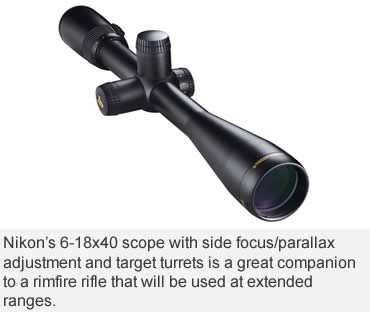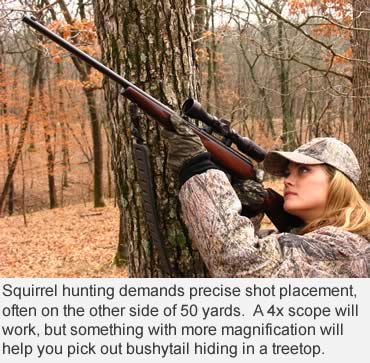How much magnification is best for small-game hunting?
“Don’t scrimp on a rimfire riflescope; it is likely the scope you’re going to use the most.”
That’s good advice from Pat Mundy, markeing communcations manager at Leupold.
Mundy says most hunters shoot approximately one box of cartridges in their centerfire rifles each year. But they fire hundreds of rimfire cartridges in their .17 HMR or .22 Long Rifle guns annually.
Another reason not to skimp on a .22 scope, says Swarovski Optik’s Rob Lancellotti, is shot placement.
“We generally use rimfires to shoot at really small targets,” he says. “Precise shooting justifies reliable optics.”
The main difference between centerfire and rimfire scopes is the parallax setting.
Technically speaking, parallax is the apparent displacement or difference of orientation of an object viewed along two different lines of sight.
In his book “Optics for the Hunter,” John Barsness explains parallax well. Form a circle with your thumb and forefinger, and extend your arm. Close one eye and aim that circle at an object. Hold your hand steady and move your head back and forth. The object will move inside the circle. That’s parallax.
Another illustration shows how parallax affects shooting. Lay a riflescope with a 100-yard parallax setting across sandbags. Point the rifle at a target 25 yards away, look through the scope, and move your head from side to side. The reticle will move on the target.
In other words, with an improper parallax setting, you can aim at a different spot than your bullet will hit. In hillbilly language, that’s called a miss.
The closer parallax is set to the distance you are shooting, the better off you’ll be.
For hunters wanting to maximize their rimfire shooting options, a long-range riflescope with an adjustable parallax might be the ticket, says John LaCorte, senior product marketing manager for Nikon.
“If you are selecting a scope for a flat-shooting .17 HMR rifle, this can be an especially good idea,” LaCorte says. “It would also be a very good choice for any .22 Long Rifle gun you plan to use at ranges close to 100 yards or farther.
LaCorte knows what he’s talking about. I used a Nikon Buckmasters 6-18x40 riflescope with side-focus parallax adjustment on a .17 HMR during a prairie dog shoot with spectacular results.
A downside to using a hunting or target scope on a .22 is the scope’s large size.
“While aesthetics is not important to performance or necessary for success, matching the riflescope to the rifle is something every hunter or shooter should consider,” LaCorte adds. “A smaller 4x32 or 2-7x32 scope is a better choice for a slim and trim .22.”
Mounting a big riflescope on a .22 can make it ungainly, unwieldy and unbalanced. This might not affect benchrest accuracy, but will cause groups to open up when shooting offhand.
Eye relief is another consideration Long-eye-relief scopes are important when training young or new shooters who have a tendency to pull away from the riflescope, taking their eye off the target.
 “A scope with 3.5 to 4 inches of eye relief will allow the shooter to feel more comfortable,” LaCorte notes.
“A scope with 3.5 to 4 inches of eye relief will allow the shooter to feel more comfortable,” LaCorte notes.
For beginning hunters, he recommends a fixed 4-power scope or a 2-7x variable f. Too much magnification can make it difficult for an inexperienced hunter find the target.
Some rimfire rifles have limited mounting space. The more generous the eye relief, the more flexibility you must have in scope mounting.
This brings up what might be the most difficult decision hunters make when choosing any riflescope: What should the magnification be?
“Don’t overlook a small fixed-power riflescope,” Pat Mundy suggests. Four power has been the standard rimfire magnification for generations. There’s a good reason for that. It works!
Conversely, if you hunt small game and need precise shot placement or if you shoot at fairly long ranges, consider a variable.
The best-selling rimfire riflescopes have always been a fixed 4x or a 2-7x variable, Mundy notes.
Non-magnifying, parallax-free, red-dot-style sights can be fun on a rimfires, but it has been my experience they lack the magnification and resolution necessary for many hunting applications.
Red-dot scopes are a hoot for shooting reactive targets at the range. But when I’ve tried these scopes for squirrel hunting, I struggled to hit anything yond 25 yards.
Futher, red-dot reticles are so large, they obscure rabbits, squirrels and other small game.
So what about reticle selection in a rimfire riflescope? The thin or standard duplex-style reticle is most common because it allows precise sight alignment. Thicker reticles help in low light, but if you’re using a rimfire in near dark conditions, a lighted reticle might be a better idea.
I’ve also found many of the ballistic reticles are effective when shooting rimfires at long range. Of course, the additional aiming points will correspond to different distances than they would on a centerfire rifle.
As for riflescope construction and optical features, you don’t have to sacrifice quality because the riflescope is just going on a rimfire.
 Michael Kinn with ATK, the parent company of Weaver Optics, says hunters looking for a rimfire scope should demand the same construction and features you would expect with a centerfire riflescope. one-piece, aircraft-grade aluminum tubes and a waterproof, fog-proof and shockproof guarantee.
Michael Kinn with ATK, the parent company of Weaver Optics, says hunters looking for a rimfire scope should demand the same construction and features you would expect with a centerfire riflescope. one-piece, aircraft-grade aluminum tubes and a waterproof, fog-proof and shockproof guarantee.
Zeiss’ Rich Montcrief says that rimfire riflescopes, like rimfire rifle,s come in all sorts of configurations at different price-points and with varying levels of performance.
There’s also no reason to stick to a traditional .22 rimfire riflescope design.
My advice: For a general-purpose .22 hunting rifle, go with a 4x or 2-7x rimfire riflescope.
For a rifle you will use for tiny targets like squirrels or gophers inside 70 yards. a 2-7x rimfire scope is ideal.
If you plan to stretch it out to 100 yards, a variable rimfire or centerfire riflescope with an adjustable objective in 3-9c or maybe even 4-12c can be a great choice.
For a flat-shooting .17 HMR, I recommend thinking outside the box. A high-magnification, variable scope designed for big game, varmint hunting or target shooting.
Sources
Nikon
(800) 645-6687
www.nikonhunting.com
Leupold
(800) 538-7653
www.leupold.com
Swarovski Optik
(800) 426-8039
www.swarovskioptik.com
Weaver
(866) 788-7386
www.weaveroptics.com
Zeiss
(800) 441-3005
www.zeiss.com/sports
This article was published in the September 2009 edition of Buckmasters GunHunter Magazine. Subscribe today to have GunHunter delivered to your home.